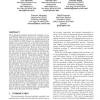Free Online Productivity Tools
i2Speak
i2Symbol
i2OCR
iTex2Img
iWeb2Print
iWeb2Shot
i2Type
iPdf2Split
iPdf2Merge
i2Bopomofo
i2Arabic
i2Style
i2Image
i2PDF
iLatex2Rtf
Sci2ools
IMC
2010
ACM
2010
ACM
Internet background radiation revisited
The monitoring of packets destined for reachable, yet unused, Internet addresses has proven to be a useful technique for measuring a variety of specific Internet phenomenon (e.g., worms, DDoS). In 2004, Pang et al. stepped beyond these targeted uses and provided one of the first generic characterizations of this non-productive traffic, demonstrating both its significant size and diversity. However, the six years that followed this study have seen tremendous changes in both the types of malicious activity on the Internet and the quantity and quality of unused address space. In this paper, we revisit the state of Internet "background radiation" through the lens of two unique data-sets: a five-year collection from a single unused /8 network block, and week-long collections from three recently allocated /8 network blocks. Through the longitudinal study of the long-lived block, comparisons between blocks, and extensive case studies of traffic in these blocks, we characterize the ...
| Added | 13 Feb 2011 |
| Updated | 13 Feb 2011 |
| Type | Journal |
| Year | 2010 |
| Where | IMC |
| Authors | Eric Wustrow, Manish Karir, Michael Bailey, Farnam Jahanian, Geoff Huston |
Comments (0)

